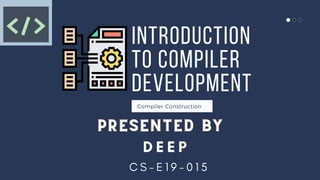
Introduction to compiler development
- 1. INTRODUCTION TO COMPILER DEVELOPMENT Compiler Construction PRESENTED BY PRESENTED BY PRESENTED BY D E E P C S - E 1 9 - 0 1 5
- 2. WHAT IS COMPILER A compiler is a special program that processes statements written in a particular programming language and turns them into machine language or "code" that a computer's processor uses. Typically, a programmer writes language statements in a language such as C++ or C one line at a time using an editor. The file that is created contains what are called the source statements. The programmer then runs the appropriate language compiler, specifying the name of the file that contains the source statements.
- 3. Towards the end of the 1950s, machine-independent programming languages were first proposed. Subsequently, several experimental compilers were developed. The first compiler was written by Grace Hopper, in 1952, for the A-0 programming language. The FORTRAN team led by John Backus at IBM is generally credited as having introduced the first complete compiler in 1957. COBOL was an early language to be compiled on multiple architectures, in 1960 HISTORY OF COMPILER
- 4. WHY DO WE NEED A COMPILER? A Computer understands only binary language and executes instructions coded in binary language. It cannot execute a single instruction given in any other form. Therefore, we must provide instructions to the computer in binary language. Means we must write computer programs entirely in binary language (sequence of 0s and 1s). So, there was a need of a translator that translates the computer instructions given in English language to binary language.
- 5. Computers do not understand human languages. In fact, at the lowest level, computers only understand sequences of numbers that represent operational codes (op codes for short). On the other hand, it would be very difficult for humans to write programs in terms of op codes. Therefore, programming languages were invented to make it easier for humans to write computer programs. Programming languages are for humans to read and understand. The program (source code) must be translated into machine language so that the computer can execute the program (as the computer only understands machine language). The way that this translation occurs depends on whether the programming language is a compiled language or an interpreted language. HOW COMPILER WORKS
- 6. WORK OF PHASES The compilation process is a sequence of various phases. Each phase takes input from its previous stage, has its own representation of source program, and feeds its output to the next phase of the compiler. Let us understand the phases of a compiler. HOW COMPILER WORK THROUGH ITS PHASES
- 7. LEXICAL ANALYSIS The first phase of scanner works as a text scanner. This phase scans the source code as a stream of characters and converts it into meaningful lexemes. Lexical analyzer represents these lexemes in the form of tokens as: <token-name, attribute-value>
- 8. #include <iostream> int main() { cout << "Hello World!"; return 0; } HELLO WORLD PROGRAM
- 9. SYNTAX ANALYSIS The next phase is called the syntax analysis or parsing. It takes the token produced by lexical analysis as input and generates a parse tree (or syntax tree). In this phase, token arrangements are checked against the source code grammar, i.e. the parser checks if the expression made by the tokens is syntactically correct.
- 10. SEMANTIC ANALYSIS Semantic analysis checks whether the parse tree constructed follows the rules of language. For example, assignment of values is between compatible data types, and adding string to an integer. Also, the semantic analyzer keeps track of identifiers, their types and expressions; whether identifiers are declared before use or not etc. The semantic analyzer produces an annotated syntax tree as an output.
- 11. After semantic analysis, the compiler generates an intermediate code of the source code for the target machine. It represents a program for some abstract machine. It is in between the high-level language and the machine language. This intermediate code should be generated in such a way that it makes it easier to be translated into the target machine code. INTERMEDIATE CODE GENERATION
- 12. CODE OPTIMIZATION THE NEXT PHASE DOES CODE OPTIMIZATION OF THE INTERMEDIATE CODE. OPTIMIZATION CAN BE ASSUMED AS SOMETHING THAT REMOVES UNNECESSARY CODE LINES, AND ARRANGES THE SEQUENCE OF STATEMENTS IN ORDER TO SPEED UP THE PROGRAM EXECUTION WITHOUT WASTING RESOURCES (CPU, MEMORY).
- 13. CODE GENERATION IN THIS PHASE, THE CODE GENERATOR TAKES THE OPTIMIZED REPRESENTATION OF THE INTERMEDIATE CODE AND MAPS IT TO THE TARGET MACHINE LANGUAGE. THE CODE GENERATOR TRANSLATES THE INTERMEDIATE CODE INTO A SEQUENCE OF (GENERALLY) RE-LOCATABLE MACHINE CODE. SEQUENCE OF INSTRUCTIONS OF MACHINE CODE PERFORMS THE TASK AS THE INTERMEDIATE CODE WOULD DO.
- 14. SYMBOL TABLE IT IS A DATA-STRUCTURE MAINTAINED THROUGHOUT ALL THE PHASES OF A COMPILER. ALL THE IDENTIFIER'S NAMES ALONG WITH THEIR TYPES ARE STORED HERE. THE SYMBOL TABLE MAKES IT EASIER FOR THE COMPILER TO QUICKLY SEARCH THE IDENTIFIER RECORD AND RETRIEVE IT. THE SYMBOL TABLE IS ALSO USED FOR SCOPE MANAGEMENT.
- 15. Thank you Q&A YOU MAY ASK